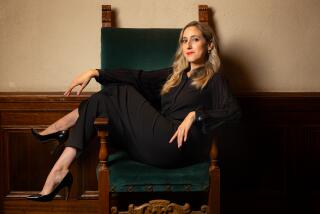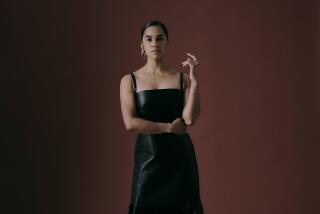The Chopin shuffle
- Share via
Chopin never wrote a ballet. But that hasn’t stopped choreographers from mining his music. Fokine created “Chopiniana” in 1894 and revised it in 1908, and it appeared in that enduring form under a new title, “Les Sylphides,” when Diaghilev introduced it to the West in 1909.
Ashton created the heartbreaking “A Month in the Country” in 1976. Robbins couldn’t keep away either. Count four Robbins ballets set to his music: “The Concert” (1956), “Dances at a Gathering” (1969), “In the Night” (1970) and “Other Dances” (1974). The last three are classics.
Against such luminaries, choreographing another Chopin ballet may seem an almost reckless act. But what Dwight Rhoden, co-founder of Complexions Contemporary Ballet, brings to the table in his 2007 work, “Dear Frederic,” that the others don’t is a dedicated focus on the composer’s energy and use of counterpoint.
Rhoden’s Chopin is no pale, terminally ill Romantic languishing in Paris salons. He’s a successor to Bach and an inheritor of Baroque drive.
Excerpts from Rhoden’s plotless “Dear Frederic” opened a sensational seven-part program Friday at the Dorothy Chandler Pavilion by the company Rhoden founded in 1994 with his then-partner and always-muse, dancer Desmond Richardson.
Some have found Rhoden’s nonstop, hyperactive choreography shallow and wearing. He takes classical ballet positions and warps them with movements from modern, street or acrobatic dance. Hips shake, arms jerk, torsos bend, then feet fly off the floor in perfect entrechats or dancers melt into gorgeous arabesques. It’s easy to be turned on -- or distracted -- by all the activity, but that’s just the tip of the iceberg.
--
A refocusing
Rhoden really hears what’s going on in the music, and not only in Chopin but also in Handel and John Cage (both in “Momentary Forevers”) and the marvelous Marvin Gaye (“Chapters”). All three works, also on the program, were created after Rhoden suffered a massive heart attack in 2005 that refocused his life and work.
Danced to unsubtle, almost painfully amplified recorded playing by pianist Henry Wong Doe, “Dear Frederic” married movement and musical phrase structure in ingenious, unpredictable, sensitive, often classically symmetrical forms.
Events happened at breathtaking speed, even at slow tempos. But they remained clear and purposeful because the terrific dancers were up to Rhoden’s demands. Clifford C. Williams and Christie Partelow danced the opening duet to a transcription of the Sonata No. 2. Bryan Arias was the virtuoso soloist in the Sonata No. 1. Arias and Gary W. Jeter II made the challenging duet to the tempestuous Opus 10, No. 4, etude look almost easy. Wendy White Sasser and Ron Todorowski danced the Opus 68, No. 2, mazurka. The double-duet dancers (to the chromatic Opus 10, No.2, etude) were Christina Dooling, Partelow, Jeter and William Cannon.
If “Dear Frederic” was essentially an abstract ballet, excerpts from “Chapters” (2007) transformed flashy Ailey-esque grooving-in-the-night vignettes to tell a serious story: the doomed attraction and love between two men (Williams and Todorowski) torn apart by societal conventions.
Their love took place in fleeting moments in the background. But when Todorowski appeared as a nervous cross-dresser two-thirds of the way through the piece, the audience howled, missing how courageous and vulnerable an act it was, which would lead to the character’s death and an everlasting, alienating guilt among the partyers left behind.
--
Love letter
At the exact center -- the heart -- of the program was Taye Diggs’ “Loose Change,” a solo created last year for Richardson, who danced it with authority, grace and power. Heightened by singer David Ryan Harris’ recurring line, “If I had a dime for every time I wanted you,” the piece came across as a company love letter to Richardson that was deservedly matched by the audience’s response.
It was the only piece on the program not created by Rhoden, the company’s resident choreographer. (Slightly different programs were scheduled for Saturday and Sunday.) Musicality, innovation, purpose, consistency, a brilliant use of stage space and the ability to tell a story -- all these qualities make him one of today’s elect choreographers.
--
More to Read
The biggest entertainment stories
Get our big stories about Hollywood, film, television, music, arts, culture and more right in your inbox as soon as they publish.
You may occasionally receive promotional content from the Los Angeles Times.










